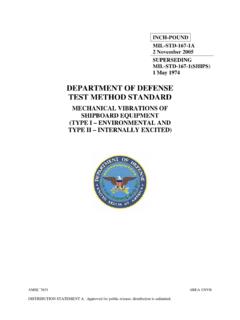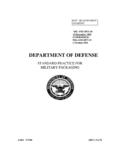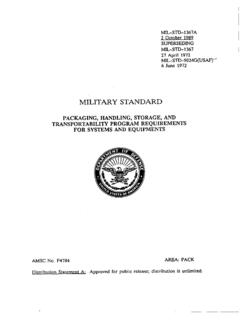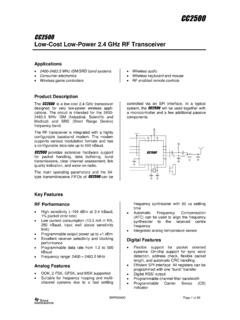Transcription of DEPARTMENT OF DEFENSE INTERFACE STANDARD
1 MIL-STD-461E20 AUGUST 1999_____SUPERSEDINGMIL-STD-461D11 JANUARY 1993 MIL-STD-462D11 JANUARY 1993 DEPARTMENT OF DEFENSEINTERFACE STANDARDREQUIREMENTS FOR THE CONTROL OFELECTROMAGNETIC INTERFERENCECHARACTERISTICS OF SUBSYSTEMS ANDEQUIPMENTAMSC F7352 AREA EMCSDISTRIBUTION STATEMENT A. Approved for public release; distribution is This military STANDARD is approved for use by all Departments and Agencies of the Departmentof Beneficial comments (recommendations, additions, deletions) and any pertinent data whichmay be of use in improving this document should be addressed to: ASC/ENSI, 2530 Loop RoadWest, Wright-Patterson Air Force Base, OH 45433-7101, by using the self-addressedStandardization Document Improvement Proposal (DD Form 1426) appearing at the end of thisdocument or by The test requirements previously contained in MIL-STD-462 used to verify compliance withMIL-STD-461 have been included in this version of The stated INTERFACE requirements are considered necessary to provide reasonable confidencethat a particular subsystem or equipment complying with these requirements will function withintheir designated design tolerances when operating in their intended electromagnetic environment(EME).
2 The procuring activity should consider tailoring the individual requirements to be moreor less severe based on the design features of the intended platform and its mission in concertwith personnel knowledgeable about electromagnetic compatibility issues affecting An appendix is included which provides the rationale and background for each requirementand verification A committee consisting of representatives of the Army, Air Force, Navy, other DoD agencies,and Industry prepared this General Tailoring of Emission and susceptibility APPLICABLE Government Government documents, drawings, and Non-Government Order of Acronyms used in this Above Below External Flight-line Internal Metric Non-developmental Safety Test setup GENERAL INTERFACE Joint Filtering (Navy only).. Non-Developmental Items (NDI).
3 Commercial Selected by Specified by procuring Procurement of equipment or subsystems having met other Government Furnished Equipment (GFE).. Switching Verification Measurement Shielded Radio Frequency (RF) absorber Other test Ambient electromagnetic Ground Metallic ground Composite ground Power source General test Accessory Excess personnel and Overload RF Shock Federal Communications Commission (FCC) EUT test EUT design Bonding of Shock and vibration Safety Orientation of Construction and arrangement of EUT Interconnecting leads and Input power Electrical and mechanical Operation of Operating frequencies for tunable RF Operating frequencies for spread spectrum Susceptibility Use of measurement Computer-controlled Emission Emission Frequency Emission data Susceptibility Frequency Modulation of susceptibility Thresholds of Calibration of measuring Measurement system Antenna DETAILED Units of frequency domain EMI control requirements versus intended Emission and susceptibility requirements, limits, and test CE101, conducted emissions, power leads, 30 Hz to 10 CE101 CE101 CE101 test Test Data CE102, conducted emissions, power leads.
4 10 kHz to 10 CE102 CE102 CE102 test Test Data CE106, conducted emissions, antenna terminal, 10 kHz to 40 CE106 CE106 CE106 test Test Transmit mode for transmitters and Receivers and stand-by mode for transmitters and Data Transmit mode for transmitters and Receivers and stand-by mode for transmitters and CS101, conducted susceptibility, power leads, 30 Hz to 150 CS101 CS101 CS101 test Test Data CS103, conducted susceptibility, antenna port, intermodulation, 15 kHz to CS103 CS103 CS103 test Test CS104, conducted susceptibility, antenna port, rejection of undesired signals,30 Hz to 20 CS104 CS104 CS104 test Test CS105, conducted susceptibility, antenna port, cross modulation, 30 Hz to20 CS105 CS105 CS105 test Test CS109, conducted susceptibility, structure current, 60 Hz to 100 CS109 CS109 CS109 test Test Data CS114, conducted susceptibility, bulk cable injection, 10 kHz to 200 CS114 CS114 CS114 test Test Data CS115, Conducted susceptibility, bulk cable injection, impulse CS115 CS115 CS115 test Test Data CS116, conducted susceptibility, damped sinusoidal transients, cables andpower leads, 10 kHz to 100 CS116 CS116 CS116 test Test Data RE101, Radiated emissions, magnetic field, 30 Hz to 100 RE101 RE101 RE101 test Test Data RE102, radiated emissions, electric field, 10 kHz to 18 RE102 RE102 RE102 test Test Data RE103, radiated emissions.
5 Antenna spurious and harmonic outputs, 10 kHzto 40 RE103 RE103 RE103 test Test Data RS101, radiated susceptibility, magnetic field, 30 Hz to 100 RS101 RS101 RS101 test Test Data RS101 alternative test procedures AC Helmholtz Test Data RS103, radiated susceptibility, electric field, 2 MHz to 40 RS103 RS103 RS103 test Test Data RS103 alternative test procedures reverberation chamber (mode-tuned).. Test Data RS105, radiated susceptibility, transient electromagnetic RS105 RS105 RS105 test Test Data Intended Issue of Associated Data Item Tailoring Subject term (key word) International standardization Changes from previous Technical points of 1. RF absorber loading 2. General test 3. Test setup for non-conductive surface mounted 4.
6 Test setup for free standing EUT in shielded 5. Test setup for free standing 6. LISN 7. LISN CE101-1. CE101 limit for submarine applications, CE101-2. CE101 limit for submarine applications, 60 CE101-3. CE101 limit for submarine applications, 400 CE101-4. CE101 limit for Navy ASW aircraft and Army aircraft (includingflight line) CE101-5. Measurement system CE101-6. Measurement CE102-1. CE102 limit (EUT power leads, AC and DC) for all CE102-2. Measurement system check CE102-3. Measurement CE106-1. Setup for low power transmitters and CE106-2. Setup for high power transmitters and CE106-3. Setup for receivers and stand-by mode for transmitters CS101-1. CS101 voltage limit for all CS101-2. CS101 power limit for all CS101-3. CS101-4. Signal injection, DC or single phase CS101-5. Signal injection, 3-phase CS101-6. Signal injection, 3-phase CS109-1.
7 CS109 limit for all CS109-2. Test CS114-1. CS114 calibration limit for all CS114-2. Maximum insertion loss for injection CS114-3. Calibration CS114-4. Bulk cable injection CS115-1. CS115 signal characteristics for all CS115-2. Calibration CS115-3. Bulk cable CS116-1. Typical CS116 damped sinusoidal CS116-2. CS116 limit for all CS116-3. Typical test setup for calibration of test CS116-4. Typical set up for bulk cable injection of damped RE101-1. RE101 limit for all Army RE101-2. RE101 limit for all Navy RE101-3. Calibration RE101-4. Basic test RE102-1. RE102 limit for surface ship RE102-2. RE102 limit for submarine RE102-3. RE102 limit for aircraft and space system RE102-4. RE102 limit for ground RE102-5. Basic test RE102-6. Antenna RE102-7. Multiple antenna RE103-1. Calibration and test setup for radiated harmonics and spuriousemissions, 10 kHz to 1 RE103-2.
8 Calibration and test setup for radiated harmonics and spuriousemissions, 1 GHz to 40 RS101-1. RS101 limit for all Navy RS101-2. RS101 limit for all Army RS101-3. Calibration of the radiating RS101-4. Basic test RS101-5. Calibration of Helmholtz RS101-6. Test setup for Helmholtz RS103-1. Test equipment RS103-2. Multiple test antenna locations for frequency > 200 RS103-3. Multiple test antenna locations for N positions, D > 3 RS103-4. Receive antenna procedure (1 to 40 GHz)..132 FIGURE RS103-5. Reveberation chamber RS103-6. Reverberation Chamber RS105-1. RS105 limit for all RS105-2. Typical calibration setup using parallel plate radiation RS105-3. Typical test setup using parallel plate radiation I. Absorption at normal II. Bandwidth and measurement III. Susceptibility IV. Emission and susceptibility V. Requirement VI.
9 CS114 limit VII. RS103 VIII. Required number of tuner positions for a reverberation A: MIL-STD-461E Application GuideA-1 MIL-STD-461E11. STANDARD establishes INTERFACE and associated verification requirements for the control of theelectromagnetic interference (emission and susceptibility) characteristics of electronic, electrical,and electromechanical equipment and subsystems designed or procured for use by activities andagencies of the DEPARTMENT of DEFENSE . Such equipment and subsystems may be usedindependently or as an integral part of other subsystems or systems. This STANDARD is best suitedfor items that have the following features: electronic enclosures that are no larger than anequipment rack, electrical interconnections that are discrete wiring harnesses between enclosures,and electrical power input derived from prime power sources. This STANDARD should not bedirectly applied to items such as modules located inside electronic enclosures or entire principles in this STANDARD may be useful as a basis for developing suitable requirements forthose applications.
10 Data item requirements are also General applicability. The applicability of the emission and susceptibility requirements is dependent upon the types ofequipment or subsystems and their intended installations as specified Tailoring of environmental criteria may be derived from operational and engineeringanalyses on equipment or subsystems being procured for use in specific systems or platforms. When analyses reveal that the requirements in this STANDARD are not appropriate for thatprocurement, the requirements may be tailored and incorporated into the request-for-proposal,specification, contract, order, and so forth. The test procedures contained in this document shallbe adapted by the testing activity for each application. The adapted test procedures shall bedocumented in the Electromagnetic Interference Test Procedures (EMITP)(See ). STANDARD has two primary sections, the main body and the appendix.











